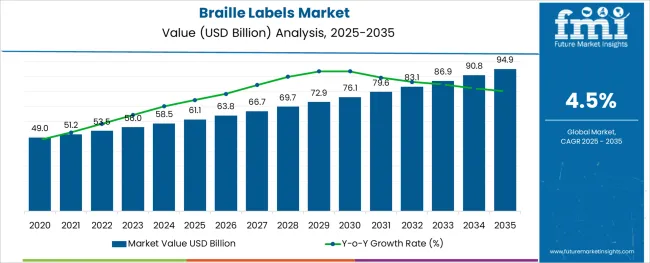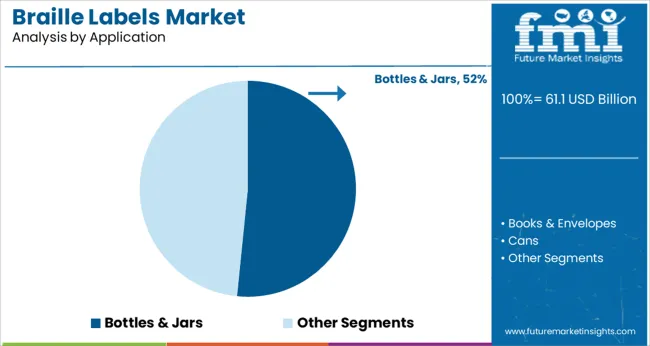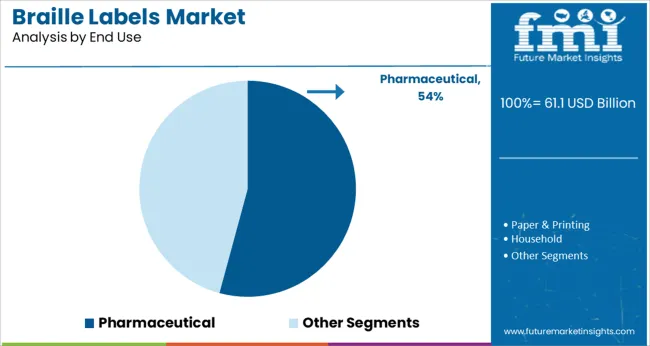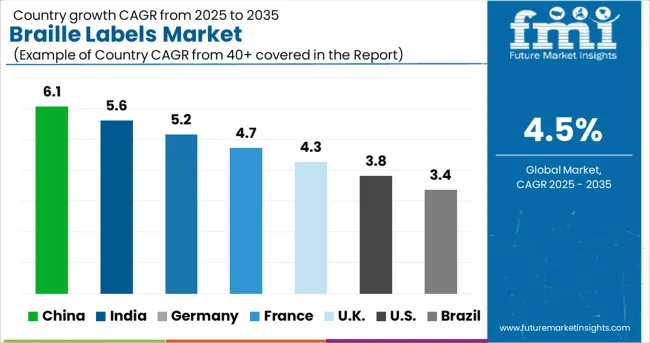The Braille Labels Market is estimated to be valued at USD 61.1 billion in 2025 and is projected to reach USD 94.9 billion by 2035, registering a compound annual growth rate (CAGR) of 4.5% over the forecast period.

The Braille labels market is gaining strong traction amid a global push toward inclusive packaging and regulatory enforcement for accessible labeling, especially in pharmaceuticals and consumer goods. The rise in visually impaired populations, coupled with the responsibility placed on brands to ensure product information is universally accessible, has intensified demand for Braille-integrated solutions.
Innovations in digital embossing, tactile printing, and adhesive technologies are supporting the seamless integration of Braille without compromising aesthetics or brand messaging. In the pharmaceutical sector particularly, Braille labeling is increasingly seen not just as a regulatory checkbox but as a consumer trust and safety feature.
Market momentum is further amplified by policy frameworks across Europe and North America that mandate accessible labeling standards. Looking ahead, sustained investments in inclusive design, regulatory harmonization, and tactile packaging enhancements are expected to fuel continued growth across core end-use sectors and applications.
The market is segmented by Material Type, Application, and End Use and region. By Material Type, the market is divided into Plastic, PET, PE, Others, and Paper. In terms of Application, the market is classified into Bottles & Jars, Books & Envelopes, Cans, Household Appliances, and Others. Based on End Use, the market is segmented into Pharmaceutical, Paper & Printing, Household, Food & Beverages, and Others. Regionally, the market is classified into North America, Latin America, Western Europe, Eastern Europe, Balkan & Baltic Countries, Russia & Belarus, Central Asia, East Asia, South Asia & Pacific, and the Middle East & Africa.

It is observed that bottles and jars account for 51.60% of the overall market revenue, establishing this format as the leading application in the Braille labels market. This predominance is driven by the prevalence of rigid packaging in pharmaceuticals, personal care, and household products where labeling surface is both essential and consistent.
Braille labels on bottles and jars ensure secure placement, readability, and longevity, especially during distribution and handling. The rigid structure of these containers supports better adhesion and tactile legibility, making them highly compatible with embossed or raised-print formats.
Moreover, bottles and jars are frequently used for unit-dosage or consumable items, which necessitate accurate identification and usage instructions for visually impaired consumers. These operational and compliance benefits have collectively strengthened the position of this application format as the market leader.

It is identified that the pharmaceutical segment holds 54.20% of the total market revenue, making it the dominant end-use category in the Braille labels landscape. This is attributed to stringent global regulations that require medicinal packaging to include Braille for product name and dosage details to enhance patient safety. European directives and health authority guidelines have especially accelerated adoption, with pharmaceutical manufacturers implementing Braille as a core packaging component.
Beyond compliance, Braille labeling in this sector reinforces brand integrity, consumer trust, and product authenticity. The nature of pharmaceutical packaging often involving blister packs, vials, and prescription bottles makes tactile labeling essential for identification by visually impaired patients.
Additionally, the growing elderly demographic has increased the need for accessible medical packaging. The combination of legislative compulsion and human-centered design imperatives has firmly positioned the pharmaceutical industry as the primary driver of demand for Braille labels.
Braille labels market has witnessed a strong growth in the last few years due to growing urbanization and increasing literacy rates in the developing countries. Companies are also introducing products with braille labels on it. For e.g. a wine company, M. Chapoutier, based in France incorporated braille labels on its wine bottles to make it easier for the blind people to shop wine conveniently.
Some researchers indicates that the world’s blind population will increase three-fold from about 35 million today to approximately 110 million in 2050 which is a significant rise in the next few decades.
This will create the high demand for the braille labels in the market. Some of the restraints in the braille labels market is the lower quality of the labels produced by the local manufacturers at higher prices. However, it is expected that the market will soon become fragmented with the rise in number of manufacturers in the market.
Braille labels market offers significant opportunities for the new entrants and existing market players to increase the reach of their products to a global level.
Among the end use, pharmaceutical and paper & printing segment is expected to dominate the braille labels market, during the forecast period.

On the basis of region, the Braille Labels market is segmented into seven regions which include North America, Latin America, Eastern Europe, Western Europe, Asia-Pacific, Middle East & Africa, and Japan.
The North America and Europe dominate the market due to high technological advancements in the region with high focus of different end use companies to offer convenient packaging solution to every age group and also to differently abled people.
Also, some rules and regulations in the pharmaceutical industry make pharmaceutical companies to use blind-people friendly packaging solutions on their products. Asia-Pacific, Latin America, and MEA also offer untapped growth potential in the braille labels market share.
However, Japan already has high penetration of convenient and user-friendly packaging solutions such as braille labels.
The report is a compilation of first-hand information, qualitative and quantitative assessment by industry analysts, inputs from industry experts and industry participants across the value chain.
The report provides in-depth analysis of parent market trends, macro-economic indicators and governing factors along with market attractiveness as per segments.
The report also maps the qualitative impact of various market factors on market segments and geographies.

Some of the key players in the Braille Labels market are American Thermoform Corporation, APH, Inc., LS&S, LLC, Pia - Accessible Printing Solutions, Rath Microtech, Quantum Technology Pty Ltd, Awards USA, Aspect Labelling Limited, Romer Etikett GmbH & Co KG, CCL Label GmbH, and Sleever International Company.
The research report presents a comprehensive assessment of the market and contains thoughtful insights, facts, historical data, and statistically supported and industry-validated market data.
It also contains projections using a suitable set of assumptions and methodologies. The research report provides analysis and information according to market segments such as geographies, application, and industry.
The global braille labels market is estimated to be valued at USD 61.1 billion in 2025.
It is projected to reach USD 94.9 billion by 2035.
The market is expected to grow at a 4.5% CAGR between 2025 and 2035.
The key product types are plastic, pet, pe, others and paper.
bottles & jars segment is expected to dominate with a 51.6% industry share in 2025.






Our Research Products

The "Full Research Suite" delivers actionable market intel, deep dives on markets or technologies, so clients act faster, cut risk, and unlock growth.

The Leaderboard benchmarks and ranks top vendors, classifying them as Established Leaders, Leading Challengers, or Disruptors & Challengers.

Locates where complements amplify value and substitutes erode it, forecasting net impact by horizon

We deliver granular, decision-grade intel: market sizing, 5-year forecasts, pricing, adoption, usage, revenue, and operational KPIs—plus competitor tracking, regulation, and value chains—across 60 countries broadly.

Spot the shifts before they hit your P&L. We track inflection points, adoption curves, pricing moves, and ecosystem plays to show where demand is heading, why it is changing, and what to do next across high-growth markets and disruptive tech

Real-time reads of user behavior. We track shifting priorities, perceptions of today’s and next-gen services, and provider experience, then pace how fast tech moves from trial to adoption, blending buyer, consumer, and channel inputs with social signals (#WhySwitch, #UX).

Partner with our analyst team to build a custom report designed around your business priorities. From analysing market trends to assessing competitors or crafting bespoke datasets, we tailor insights to your needs.
Supplier Intelligence
Discovery & Profiling
Capacity & Footprint
Performance & Risk
Compliance & Governance
Commercial Readiness
Who Supplies Whom
Scorecards & Shortlists
Playbooks & Docs
Category Intelligence
Definition & Scope
Demand & Use Cases
Cost Drivers
Market Structure
Supply Chain Map
Trade & Policy
Operating Norms
Deliverables
Buyer Intelligence
Account Basics
Spend & Scope
Procurement Model
Vendor Requirements
Terms & Policies
Entry Strategy
Pain Points & Triggers
Outputs
Pricing Analysis
Benchmarks
Trends
Should-Cost
Indexation
Landed Cost
Commercial Terms
Deliverables
Brand Analysis
Positioning & Value Prop
Share & Presence
Customer Evidence
Go-to-Market
Digital & Reputation
Compliance & Trust
KPIs & Gaps
Outputs
Full Research Suite comprises of:
Market outlook & trends analysis
Interviews & case studies
Strategic recommendations
Vendor profiles & capabilities analysis
5-year forecasts
8 regions and 60+ country-level data splits
Market segment data splits
12 months of continuous data updates
DELIVERED AS:
PDF EXCEL ONLINE
Competitive Breakdown of Braille Labels Manufacturers
Braille Cartons Packaging Market Size and Share Forecast Outlook 2025 to 2035
Braille Clothing Tags Market Size and Share Forecast Outlook 2025 to 2035
Industry Share Analysis for Braille Clothing Tags Companies
Leading Providers & Market Share in Braille Cartons Packaging
Digital Braille Displays Market Size and Share Forecast Outlook 2025 to 2035
Labels Market Forecast and Outlook 2025 to 2035
Labels, Tapes And Films Market Size and Share Forecast Outlook 2025 to 2035
Competitive Overview of Labels Companies
USA Labels Market Size and Share Forecast Outlook 2025 to 2035
Market Share Distribution Among USA Labels Providers
Foam Labels Market Trends and Growth 2035
Market Share Breakdown of Foil Labels Manufacturers
Foil Labels Market Analysis by Metal Foils & Polymer-Based Foils Through 2035
Kraft Labels Market Size and Share Forecast Outlook 2025 to 2035
HAZMAT Labels Market Growth and Forecast 2025 to 2035
In-mold Labels Market Size and Share Forecast Outlook 2025 to 2035
Printed Labels Market Size and Share Forecast Outlook 2025 to 2035
Sheeted Labels Market Size and Share Forecast Outlook 2025 to 2035
QR Code Labels Market Size and Share Forecast Outlook 2025 to 2035

Thank you!
You will receive an email from our Business Development Manager. Please be sure to check your SPAM/JUNK folder too.
Chat With
MaRIA